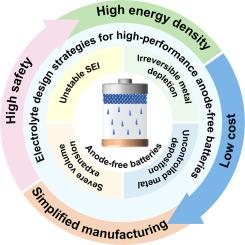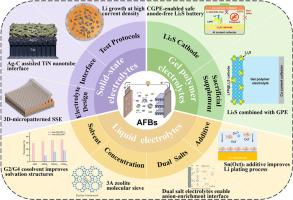From liquid to solid: Advanced electrolyte design strategies for next-generation high-performance anode-free lithium/sodium/potassium batteries
IF 20.2
1区 材料科学
Q1 CHEMISTRY, PHYSICAL
引用次数: 0
Abstract
Anode-free lithium/sodium/potassium batteries have emerged as promising candidates for next-generation energy storage due to their simplified structure, high energy density, low cost, and enhanced safety. However, their practical application is still hindered by finite metal sources and the high reactivity of metals. Recent progress in electrolyte design has demonstrated great potential to overcome these limitations. In liquid electrolytes, tailored electrolyte formulations have significantly improved the cycling performance of anode-free batteries (AFBs). Furthermore, advancements in solid-state electrolytes have further enhanced the stability of AFBs by suppressing side reactions at the solid-solid interface. This review summarizes advanced electrolyte design strategies for high-performance anode-free lithium/sodium/potassium batteries, spanning from liquid to solid-state systems. The underlying mechanisms are thoroughly analyzed, with an emphasis on electrolyte formulation and interface engineering strategies. A systematic comparison between liquid and solid electrolytes is also presented. Future directions are outlined to guide the practical application of AFBs. This review may further inspire the development of other anode-free systems, such as Al-, Mg-, and Zn-based batteries.


从液体到固体:下一代高性能无阳极锂/钠/钾电池的先进电解质设计策略
无阳极锂/钠/钾电池因其结构简化、能量密度高、成本低、安全性强等优点,已成为下一代储能技术的理想选择。然而,它们的实际应用仍然受到有限的金属来源和金属的高反应性的阻碍。电解质设计的最新进展显示了克服这些限制的巨大潜力。在液体电解质方面,量身定制的电解质配方显著提高了无阳极电池(AFBs)的循环性能。此外,固态电解质的进步通过抑制固-固界面的副反应进一步提高了AFBs的稳定性。本文综述了高性能无阳极锂/钠/钾电池的先进电解质设计策略,从液态到固态系统。深入分析了潜在的机制,重点是电解质配方和界面工程策略。本文还对液体电解质和固体电解质进行了系统的比较。展望了未来的发展方向,以指导AFBs的实际应用。这一综述可能会进一步启发其他无阳极系统的发展,如铝基、镁基和锌基电池。
本文章由计算机程序翻译,如有差异,请以英文原文为准。
求助全文
约1分钟内获得全文
求助全文
来源期刊

Energy Storage Materials
Materials Science-General Materials Science
CiteScore
33.00
自引率
5.90%
发文量
652
审稿时长
27 days
期刊介绍:
Energy Storage Materials is a global interdisciplinary journal dedicated to sharing scientific and technological advancements in materials and devices for advanced energy storage and related energy conversion, such as in metal-O2 batteries. The journal features comprehensive research articles, including full papers and short communications, as well as authoritative feature articles and reviews by leading experts in the field.
Energy Storage Materials covers a wide range of topics, including the synthesis, fabrication, structure, properties, performance, and technological applications of energy storage materials. Additionally, the journal explores strategies, policies, and developments in the field of energy storage materials and devices for sustainable energy.
Published papers are selected based on their scientific and technological significance, their ability to provide valuable new knowledge, and their relevance to the international research community.
 求助内容:
求助内容: 应助结果提醒方式:
应助结果提醒方式:


